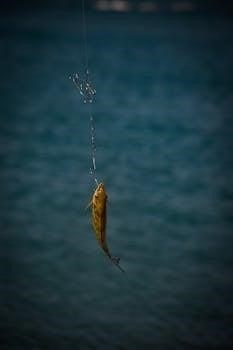
Understanding treble hook sizes is crucial for anglers aiming for successful catches. These hooks, known for their multiple points, come in a range of sizes. The numbering system, seemingly counterintuitive, needs careful attention.
Understanding Hook Numbering System
The numbering system for treble hooks can be initially confusing, as smaller numbers actually indicate larger hooks. For example, a size 1 treble hook is larger than a size 3 hook, assuming they are the same model and style. This logic applies not only to treble hooks but also to traditional J hooks and circle hooks. It is important to note that this system is different from, say, measuring something in inches or centimeters. Therefore, it is crucial to remember the numbering convention when selecting the right hook for your fishing needs;
Treble Hook Size Progression
Treble hook sizes follow a unique progression where the smaller the number, the larger the hook. This is essential to remember when choosing the correct size for your fishing needs.
Smaller Numbers Indicate Larger Hooks
When examining treble hook sizes, it’s crucial to understand that the numbering system works in reverse. A size 1 treble hook is substantially larger than a size 3 hook, assuming they are of the same model and style. This applies to various hook types including traditional J hooks, circle hooks, and treble hooks. This concept is fundamental for anglers when selecting the appropriate hook size for their lures and target species. The seemingly counterintuitive nature of this system can often lead to confusion, so careful attention should be given to the numbers.

Importance of Hook Quality
Upgrading to premium treble hooks is a common practice, as they offer superior sharpness compared to stock versions. Anglers often seek specific shank lengths, bends, and wire diameters for optimal performance.
Replacing Stock Treble Hooks
Many anglers choose to replace the factory-installed treble hooks on their lures with higher-quality options. This is because stock trebles are often less sharp and durable compared to premium hooks. Replacing them allows for better hook penetration and increased landing rates. Factors such as hook point, shank length, and wire diameter can be customized by replacing the stock hooks. Some anglers prefer different hook styles, even on high-end lures, to match their specific fishing needs. This is a common practice among professional anglers, who are always looking for a performance edge.
Treble Hook Applications
Treble hooks are commonly found on various lure types, such as crankbaits, jerkbaits, and topwater lures. Their multiple points enhance hooking potential, making them effective for attracting and securing fish strikes.
Common Lure Types Utilizing Trebles
Treble hooks are integral to many popular fishing lures, enhancing their effectiveness. Crankbaits, with their enticing wobbling action, often feature multiple trebles to maximize hookup rates. Jerkbaits, known for their erratic movements, rely on trebles to secure strikes during pauses. Topwater lures, designed to attract fish to the surface, utilize trebles to convert explosive takes into landed fish. Spoons, pilkers and spinners are also commonly equipped with treble hooks. These versatile hooks are essential for a wide array of fishing techniques and lure designs.

Treble Hook Size Ranges
Treble hook sizes span a wide spectrum, from the tiny size 20 to the massive 20/0. Anglers select sizes based on target species and lure size. These ranges allow for diverse applications.
Smallest to Largest Available Sizes
The spectrum of available treble hook sizes is quite extensive, catering to a vast array of fishing needs. At the lower end, you’ll find incredibly small hooks, starting at size 20, which are often used for very small lures or when targeting panfish. Moving upwards, sizes increase gradually, going through numbers like 8, 6, 4, 2, and 1. Then, the sizing transitions to the aught system with 1/0, 2/0, 3/0 and so forth. The largest available treble hooks reach sizes like 20/0, which are designed for targeting very large species. This extensive range ensures there’s a treble hook for almost any fishing scenario.

Weight Differences in Treble Hooks
Treble hook weight varies significantly with size. Larger hooks, like a size 4, weigh more than smaller ones, such as a size 6, impacting lure action and overall performance in the water.
Impact of Size on Hook Weight
The size of a treble hook directly influences its weight, with larger hooks naturally being heavier. This difference in weight can have a notable impact on how a lure behaves in the water. For instance, a heavier treble hook on a crankbait might cause it to sink faster or alter its swimming action, while a lighter hook might allow for a more buoyant presentation. Anglers must consider these subtle changes to match the hook to the lure and intended fishing style. The weight difference also affects casting distance and overall balance.
Hook Size and Target Fish
Selecting the appropriate hook size is paramount, as it varies depending on the species you intend to catch. Smaller hooks are often used for panfish, while larger hooks are needed for bigger fish.
Freshwater Fishing Hook Size Range
In freshwater fishing, the hook size range is quite diverse, accommodating various species and fishing styles. Typically, sizes range from very small hooks, such as size 20, often used for delicate fly fishing, to much larger hooks, reaching up to 10/0, which are suitable for targeting large catfish. The most common sizes fall within this spectrum, varying based on the specific fish you’re after. Anglers commonly choose sizes that match the size of the bait and the mouth of the target fish to ensure a solid hookset.
Variety of Treble Hook Brands
Several brands offer quality treble hooks, with Mustad being a long-time favorite among fishermen globally. VMC also produces highly regarded, sharp, and durable treble hooks for various applications.
Mustad Treble Hooks
Mustad treble hooks are a classic choice, favored by anglers worldwide for their reliability. These hooks serve as excellent replacements for plugs, spoons, pilkers, and spinners, or as bait hooks. Mustad’s reputation stems from producing high-quality, durable hooks that consistently perform well in various fishing conditions. Their classic design has stood the test of time, making them a staple in many tackle boxes. Anglers trust Mustad for consistent performance, whether targeting freshwater or saltwater species, and their hooks have proven effective across a wide range of fishing applications and techniques.
Features of High-Performance Treble Hooks
High-performance treble hooks often feature lazer sharp needlepoints, allowing for easier penetration. These points help the hook go past the barb with greater ease, resulting in a better hookup rate.
Lazer Sharp Needlepoints
Lazer sharp needlepoints are a key feature in high-performance treble hooks, offering anglers a significant advantage. These precisely crafted points are designed to penetrate a fish’s mouth with minimal resistance, ensuring a secure hookset. The sharpness allows the hook to bypass the barb more efficiently, reducing the chance of a lost fish. This technology is often found in premium hooks, making them a preferred choice for anglers looking for a competitive edge. The enhanced penetration capability of lazer sharp needlepoints contributes to a higher success rate when fishing, making them a valuable asset in any tackle box. These hooks are designed for both freshwater and saltwater use and are an upgrade from stock hooks.
Treble Hook Styles and Shapes
Treble hooks come in various styles and shapes, with the round bend being a popular choice. These shapes influence hook performance, affecting how well a lure holds onto a fish.
Round Bend Treble Hooks
The quintessential round bend treble hook design is favored by many anglers for its reliable performance. Gamakatsu’s round bend trebles are a prime example, offering enhanced holding power. This classic shape is designed to secure fish effectively, making it a staple for various lure types. Its consistent curve helps in reducing the chance of fish throwing the hook. This style ensures that the hook penetrates and holds firmly. Its versatility makes it suitable for both freshwater and saltwater applications, contributing to its popularity among fishermen.

Resources for Hook Selection
Selecting the right hook can be simplified with hook charts. These resources provide recommendations based on fish species and geographical area, aiding anglers in making informed decisions.
Hook Charts Based on Species
Navigating the world of fishing hooks can be daunting, but hook charts based on species provide a valuable shortcut. These charts, often organized by fish type, suggest appropriate hook sizes and styles for different species. For instance, a chart might recommend smaller hooks for panfish and much larger ones for catfish. These charts are essential tools, offering anglers a quick reference guide to make informed choices. They take the guesswork out of hook selection, ensuring you’re equipped with the right gear to target your desired catch effectively, whether in freshwater or saltwater environments.